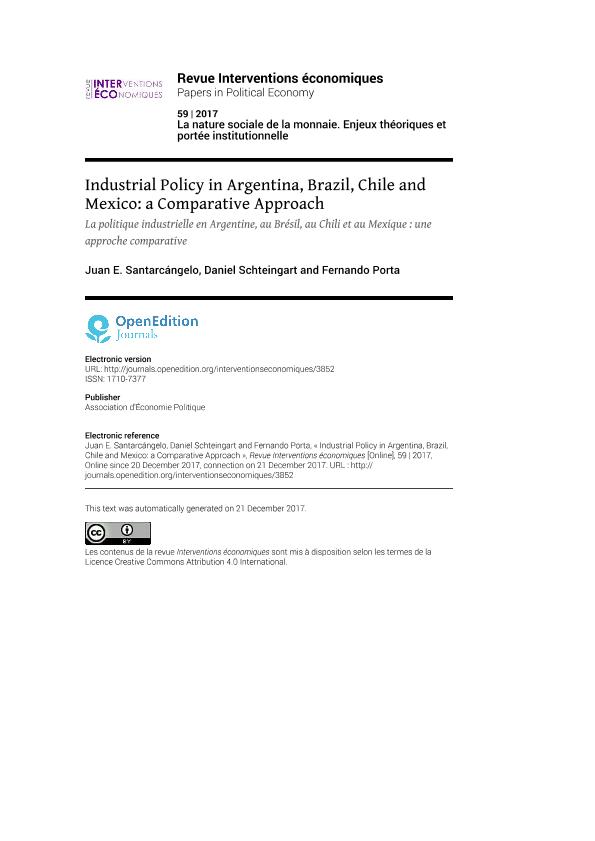Artículo
L'Amérique latine a connu une transformation importante ces dernières années. En dépit de la crise économique et sociale majeure qui a eu lieu à la fin du XXe siècle, entre 2003 et 2008, la région connaît une période expansionniste remarquable depuis les années 1970. L'une des nouvelles caractéristiques enregistrées au cours de la période était l'augmentation du secteur manufacturier où la politique industrielle combinait les instruments traditionnels pour promouvoir l'investissement avec d'autres outils visant à favoriser l'innovation et la modernisation technologique. Dans le même temps, en utilisant toujours des instruments et des programmes horizontaux, dans de nombreux pays, l'accent a été mis sur la mise en œuvre de politiques ciblées et sélectives et pour articuler les différents instruments dans un cadre plus général de planification du développement productif. L'objectif de cet article est d'analyser l'évolution des politiques industrielles récentes (IPs) et leurs résultats dans quatre pays d'Amérique latine: l'Argentine, le Brésil, le Chili et le Mexique. Pour ce faire, nous nous concentrerons sur les objectifs et les outils des IP depuis 2003, leurs différences par rapport à celles suivies dans les années 1990 et leurs changements tout au long de la période 2003-2015. Nous étudierons également les similitudes et les différences dans les approches nationales en fonction des cycles macroéconomiques et de la dynamique de la balance des paiements, des profils de spécialisation et des stratégies de développement. Latin America has experienced a significant transformation in recent years. Despite some of the countries had major economic and social crisis at the end of the twentieth century, between 2003 and 2008 the region has experienced its most remarkable expansionary period since the 1970s. One of the new features registered during the period was the increase in the manufacturing sector where industrial policy combined traditional instruments to promote investment with other tools directed towards fostering innovation and technological modernization. At the same time, still using instruments and horizontal programs, in many countries there was a greater emphasis on the implementation of targeted and selective policies and to articulate the various instruments into a more general framework of productive development planning. The aim of this paper is to analyse the evolution of recent industrial policies (IPs) and their outcomes in four Latin American countries: Argentina, Brazil, Chile and Mexico. To do this, we will focus on the objectives and tools of IPs since 2003, their differences vis-à-vis those followed in the 1990s, and their changes throughout the period 2003-2015. We will also study the similarities and differences in national approaches depending on the macroeconomic cycles and the dynamic of the balance of payments, the specialization profiles and the strategies of development.
Industrial Policy in Argentina, Brazil, Chile and Mexico: a Comparative Approach
Título:
La politique industrielle en Argentine, au Brésil, au Chili et au Mexique : une approche comparative
Fecha de publicación:
12/2017
Editorial:
Association d' Économie Politique
Revista:
Interventions économiques
ISSN:
1710-7377
Idioma:
Inglés
Tipo de recurso:
Artículo publicado
Clasificación temática:
Resumen
Palabras clave:
Industrial policy
,
Economic development
,
Latin america
,
Political economy
Archivos asociados
Licencia
Identificadores
Colecciones
Articulos(SEDE CENTRAL)
Articulos de SEDE CENTRAL
Articulos de SEDE CENTRAL
Citación
Santarcangelo, Juan Eduardo; Schteingart, Daniel Matías; Porta, Fernando Enrique; Industrial Policy in Argentina, Brazil, Chile and Mexico: a Comparative Approach; Association d' Économie Politique; Interventions économiques; 59; 12-2017; 1-42
Compartir
Altmétricas




